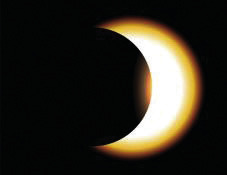Editor’s note: The following story about next Monday’s solar eclipse was written by Dr. Timothy Knudson, an assistant professor of physics who teaches about astronomy at Southern Virginia University.
Every month the moon passes the sun as they both race across the sky. As viewed from Earth, one morning you see a thin waning crescent moon rising just before the sun rises. Then, in about a week, the next time you’ll see the moon it is a thin waxing crescent moon now trailing the sun across the sky and setting just after the sun sets.
Usually, in this dance, the moon passes above or beneath the sun’s path. We don’t see the moon between these times because 1) we would be looking directly towards the sun to see it (don’t ever try that) and 2) the reflected light by which we usually see the moon is directed away from us.

However, twice a year, when the two orbits align just right, the moon passes directly in front of the sun. In a coincidence almost too good to be true, the apparent size of the moon is almost exactly the same as the apparent size of the sun; and the moon completely blocks out the sun for a few minutes: Welcome to a total solar eclipse.
Experiencing a total solar eclipse is all about location, location, location. Three things contribute to this. First, the size of the shadow cast by the moon on Earth is small – less than 200 miles wide. Second, the moon totally blocks out the sun for only a few minutes. Timing is important. And last, since two-thirds of Earth’s surface is covered by water, and the extreme north and south latitudes are sparsely populated, the odds against seeing totality on land are reduced even further.
The next solar eclipse visible from North America is this Monday, April 8. Twelve states from Texas to Maine lie in the path of totality. Our next opportunity is 20 years from now in 2044 and even then, only three states in the country will experience totality.
Rockbridge County will experience a partial eclipse on Monday. The moon’s penumbral shadow will pass over our area but not the totality of the umbral shadow. We won’t necessarily notice the darker sky during the day; but still, with the proper equipment a partial solar eclipse is definitely worth the effort to see.
In the county, at the height of the eclipse, about 87 percent of the sun’s surface will be covered. This is still enough to damage your eyes if you look at it directly. Do not try to view the eclipse without proper eye protection or through an appropriately filtered telescope.
The maximum coverage occurs at about 3:15 p.m. on Monday. The show starts here just after 2 p.m. By 2:10, the bottom right arc of the sun will clearly be “missing”. Over the next hour the sun will appear to shrink to a thin crescent. After the maximum eclipse, the moon will continue to move towards the top of the sun and the final touch occurs about 4:30 p.m.
If you can’t find eclipse glasses, your next best bet is to project a “pinhole” image of the sun onto the ground in front of you. To do this take a large flat piece of cardboard (paper may work too) and poke a small hole in the center. The size should be bigger than a pinhead and smaller than a penny – something about the size of a pea should do. Then hold the cardboard about three feet off the ground and angle it so that the sun’s rays go directly through the hole onto the ground. You should see a dark shadow in the shape of your cardboard with a bright dot at the center. Look carefully at the dot during the eclipse and you will see that there is a bite out of it. It is also possible to use the holes in a kitchen colander to project multiple images onto the ground – each hole will give you a separate sun.
Natural Bridge State Park is hosting a watch party from 2 to 4 p.m. Park Rangers will be on hand and there will be crafts and activities for younger scientists. Check out their website for full details.
If viewing the partial eclipse whets you appetite to experience totality, start planning now to visit Iceland in 2026 or Morocco in 2027.
Wherever and however you choose to view the eclipse, my wish for you is as always – clear skies.
.jpg)


